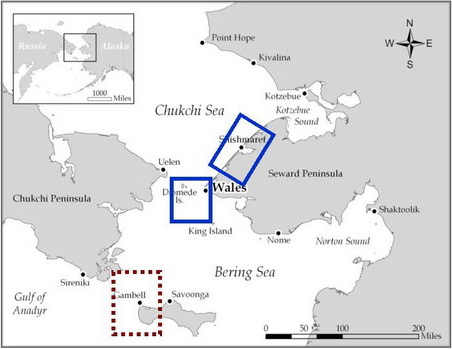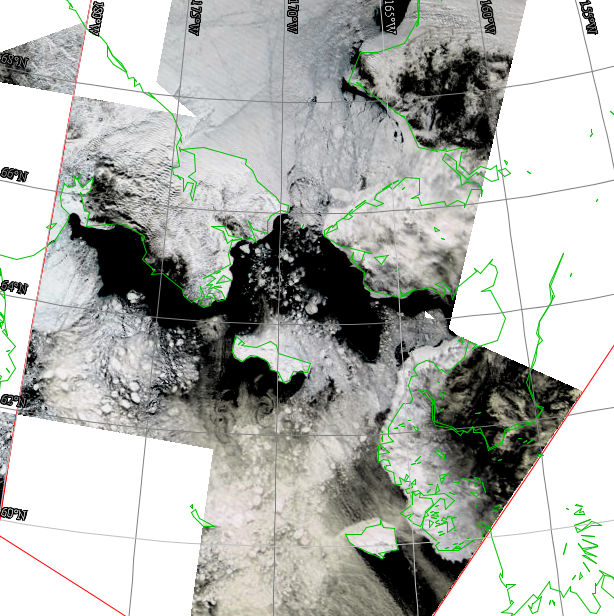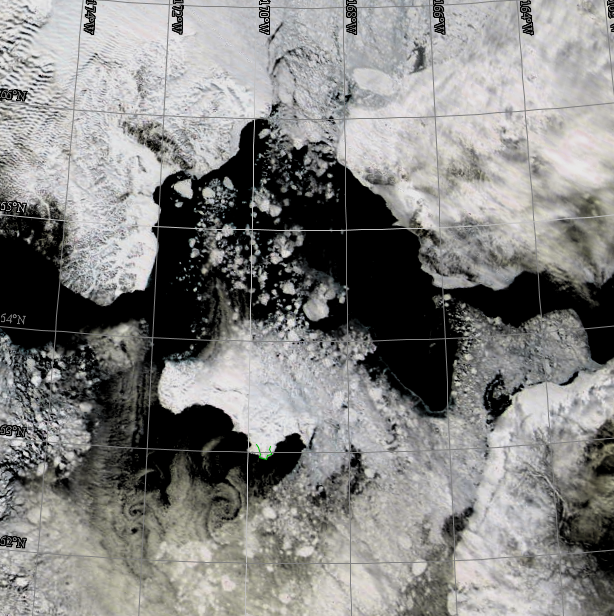Assessment of Current Ice Conditions Relevant to Distribution and Access of Walrus
St. Lawrence Island
Sea ice continues to break up south and west of St. Lawrence Island. Ice floes from very small to over 100 feet in diameter are found west of Gambell. Thirty miles west of Gambell there is very heavy pack ice still present. Sea ice remains compact against the north shore. There is a large lead between the east coast and the pack ice offshore (see the satellite images).
Wales to Shishmaref
There is now extensive open water west of Wales although shorefast ice is still present along the coast. Satellite images show the breakup of Bering Strait extending into the southern Chukchi Sea with some very large floes drifting southward in the strait. The edge of the shorefast ice continues to erode north of Shishmaref with fractures and leads now visible in the imagery. The shorefast edge is still several miles offshore.
5 to 10 Day Outlook
Winds are now NW 25 knots (30 mph) pushing sea ice down on the north shore of St. Lawrence Island, and pushing various size floes southward through the Bering Strait. The storm over southwest Alaska will drift slowly northward Saturday and stall out east of Bering Strait where it weakens. Thus winds will become lighter Saturday night and Sunday, being less than NW 15 knots (20 mph). Winds will increase on Monday, 14 May to 20 knots (25 mph) from the SE as a new low moves into the central Bering Sea. This low will slowly drift northward keeping the winds SE greater than 30 knots (35 mph) at St. Lawrence and S 25 knots (30 mph) on Wednesday. Winds will weaken on Friday and remain weak and variable through the weekend. Winds increase on Monday, 21 May to S 20 knots (25 mph).
Arrows show wind direction and wind speed in knots



Remote Sensing Images


Observations and Comments
Observations of Sea Ice Development
Comments from Gambell
10 May 2012 - Paul Apangalook
The weather has been way below freezing and windy thus far, with prevailing NE winds and the snow remaining packed and frozen on the ground. Large, low profile floes dominate the area with more and more open water by the day. The open water to the northwest may extend all the way to the Siberian coast.
Several boats try to go out every day but most return reporting high winds and rough seas further off the shore. Yesterday many boats went out in all directions taking whatever leads they could find among the large floes. A few ran into walrus about 10-15 miles out west and northwest. Several got walrus with babies. To the southwest floes are more compact with less open water. As the wind picked up opening up large leads, wind driven swells increased making the water rough. Cranes were first reported flying over the village about a week ago.
Comments from Nome
14 May 2012 - Fred Tocktoo
Most of the landfast ice is gone. Norton Sound ice is on the move, so it's going to go back and forth towards the shores with currents and wind driven actions that blow ice flows towards the beaches of the Nome area for another couple of weeks until it's all gone.
11 May 2012 - Fred Tocktoo
Yesterday (10 May) evening, Nome's shore ice started to break off on the outer portions of the landfast ice, which at a quarter of a mile or less in some places is making it easier for hunters to pull their small hunting boats for small sea mammal hunting. Hunters have been hunting seals the last week or so. Soon, as more travel on the Norton Sound becomes available, walrus will be hunted. Weather wise, it has been a very slow meltdown with about 40°F at the average and not warmer than 45°F the last several weeks.
Comments from Wales
10 May 2012 - Winton Weyapuk Jr.
Winds have been northerly so far this week, maintaining a lead along the shorefast ice which ends in a corner that has varied from 2 to 5 miles north. There are other leads offshore from the shorefast ice and strips of pack ice which show as water and ice sky. Pack ice is moving south with the wind-driven current.
